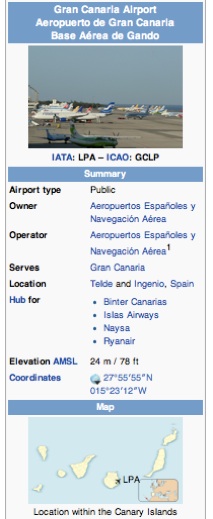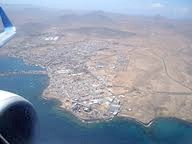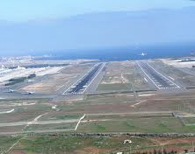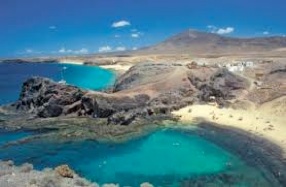
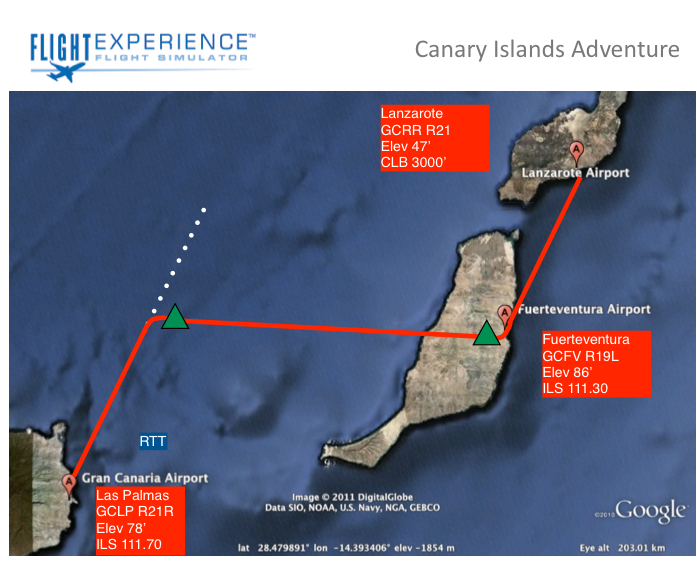
The Airports
Fuerteventura Airport (IATA: FUE, ICAO: GCFV) also known as El Matorral Airport serves the Spanish island of Fuerteventura and is situated in El Matorral site, 5 km (3.1 mi) southwest[2] of the capital city Puerto del Rosario. It was built in the mid-1960s with the arrival of tourism.
Gran Canaria Airport (IATA: LPA, ICAO: GCLP), (informally known as Las Palmas Airport, and formally known as Gando Airport), (Spanish: Aeropuerto de Gran Canaria), is the fifth busiest airport in Spain. It is an airport located on Gran Canaria Island. In 2010 it handled nearly 9.5 million passengers, a 3.6% increase compared with 2009.[1]
The airport is located in the eastern part of Gran Canaria on the Bay of Gando (Bahía de Gando), 19 km (12 mi) south[2] of Las Palmas de Gran Canaria, and 25 km (16 mi) from the popular tourist areas in the south. The lengthy runways made the airport an alternative landing site for the NASA Space Shuttle.[3]
The Canary Islands ( /kəˈnɛəriː ˈaɪləndz/; Spanish: Islas Canarias, IPA: [ˈizlas kaˈnaɾjas]), also known as the Canaries (Spanish: Canarias, Berber: Taknara), are a Spanish archipelago located just off the northwest coast of mainland Africa, 100 km west of the border between Morocco and the Western Sahara. The Canaries are a Spanish autonomous community and an outermost region of the European Union. The islands include (from largest to smallest): Tenerife, Gran Canaria, Fuerteventura, Lanzarote, La Palma, La Gomera, El Hierro, La Graciosa, Alegranza, Montaña Clara, Roque del Este, Roque del Oeste and Isla de Lobos. The Canary Islands are legally recognized as a nationality of Spain.
The archipelago's beaches, climate and important natural attractions, especially Teide National Park and Mount Teide (the third largest volcano in the world), make it a major tourist destination, with over 12 million visitors per year, especially Tenerife, Gran Canaria and Lanzarote.[7][8] The islands have a subtropical climate, with long warm summers and moderately warm winters.[9] Due to their location close to the equator yet away from tropical storms and location above the temperature inversion layer, these islands are ideal for astronomical observation. For this reason, two professional observatories, Teide Observatory on the island of Tenerife and Roque de los Muchachos Observatory on the island of La Palma, have been built on the islands.
The capital for the Autonomous Community is shared by the cities of Las Palmas and Santa Cruz,[10][11] which in turn are the capitals of the provinces of Santa Cruz de Tenerife and Las Palmas. Las Palmas de Gran Canaria has been the largest city in the Canaries since 1768, except for a brief period in 1910.[12] The third largest city of the Canary Islands is La Laguna (a World Heritage Site) on Tenerife.[13][14][15]
During the times of the Spanish Empire the Canaries were the main stopover for Spanish galleons on their way to America because of the favorable easterly winds.[16]
The Flight
Take off from Runway 21 at Lanzarote and climb to 3000. Align yourself for a straight in approach on runway 19L at Fuerteventura for a touch and go.
After departure, rurn right to 270 and intercept the ILS approach into Runway 21R at Las Palmas.

